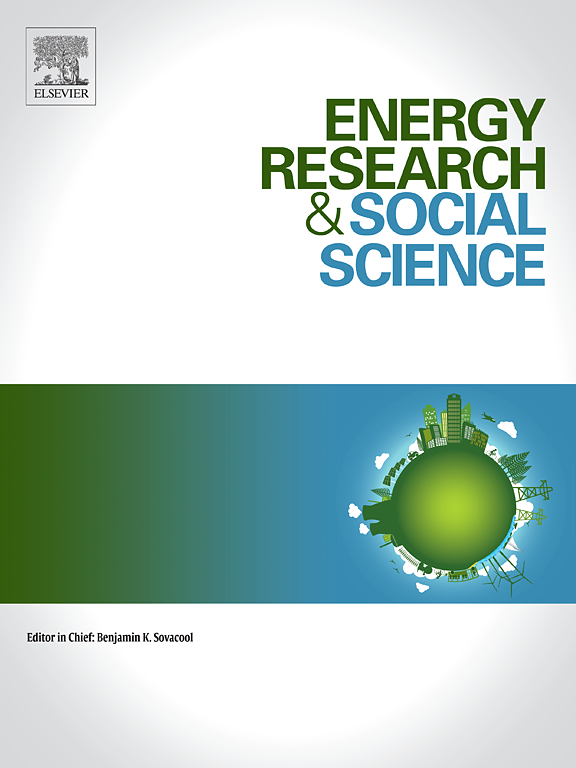Steering the electric vehicle future: Asymmetric power dynamics, system logics, and tipping mechanisms in mobility transitions
IF 6.9
2区 经济学
Q1 ENVIRONMENTAL STUDIES
引用次数: 0
Abstract
This article investigates global transition from internal combustion engines to electric vehicles (EVs), a transformation reshaping mobility systems worldwide. Despite the growing momentum of EV adoption, existing transition theories understate the role of power asymmetries, structural constraints, and cross-system interactions in shaping transition pathways. To address these gaps, we develop a novel conceptual framework that integrates the Technological Innovation Systems (TIS) and Multi-Level Perspective (MLP) approaches. Central to this framework are the concepts of system logics—the material and institutional conditions that shape regime permeability—and agency at sites of interaction, which captures stakeholder influence across systems. We conceptualize socio-technical change as a rotating spiral that progresses through dynamic feedback loops and tipping mechanisms, including political, technological, and behavioral shifts.
Empirically, we apply this framework to a comparative analysis of EV adoption in the United States, Germany, China, and Thailand. Rather than tracing uniform stages in each case, we show how distinct national contexts exemplify different phases of the global transition: from niche innovation and contested reconfiguration to state-led penetration and passive infiltration. Our findings reveal that transition trajectories are shaped by country-specific configurations of industrial maturity, policy coherence, cultural norms, and external pressures. The study offers two core contributions: a more power-sensitive and multi-system view of transition dynamics, and a typology of regime transformation pathways—active penetration and passive infiltration—that capture the diverse ways EVs challenge and reconfigure incumbent mobility systems. These insights advance transition theories and inform policymaking in both industrialized and emerging economies facing the imperatives of decarbonization and technological change.
引导电动汽车的未来:不对称动力动力学、系统逻辑和移动性转变的引爆机制
本文研究了从内燃机到电动汽车的全球转型,这是一种重塑全球移动系统的转型。尽管电动汽车的采用势头日益强劲,但现有的过渡理论低估了权力不对称、结构约束和跨系统相互作用在形成过渡路径中的作用。为了解决这些差距,我们开发了一个新的概念框架,该框架集成了技术创新系统(TIS)和多层次视角(MLP)方法。这个框架的核心是系统逻辑的概念——形成制度渗透性的物质和制度条件——以及交互场所的代理,它捕获了跨系统的利益相关者的影响。我们将社会技术变革概念化为通过动态反馈循环和引爆机制(包括政治、技术和行为转变)进行的旋转螺旋。在经验上,我们将这一框架应用于美国、德国、中国和泰国的电动汽车采用情况的比较分析。我们没有在每个案例中追踪统一的阶段,而是展示了不同的国家背景如何体现了全球转型的不同阶段:从利基创新和竞争性重构到国家主导的渗透和被动渗透。我们的研究结果表明,转型轨迹受到产业成熟度、政策一致性、文化规范和外部压力等国家具体配置的影响。该研究提供了两个核心贡献:一是对过渡动力学的更功率敏感和多系统的观点,二是制度转变途径的类型——主动渗透和被动渗透——捕捉了电动汽车挑战和重新配置现有移动系统的各种方式。这些见解推动了转型理论的发展,并为面临脱碳和技术变革的工业化和新兴经济体的政策制定提供了信息。
本文章由计算机程序翻译,如有差异,请以英文原文为准。
求助全文
约1分钟内获得全文
求助全文
来源期刊

Energy Research & Social Science
ENVIRONMENTAL STUDIES-
CiteScore
14.00
自引率
16.40%
发文量
441
审稿时长
55 days
期刊介绍:
Energy Research & Social Science (ERSS) is a peer-reviewed international journal that publishes original research and review articles examining the relationship between energy systems and society. ERSS covers a range of topics revolving around the intersection of energy technologies, fuels, and resources on one side and social processes and influences - including communities of energy users, people affected by energy production, social institutions, customs, traditions, behaviors, and policies - on the other. Put another way, ERSS investigates the social system surrounding energy technology and hardware. ERSS is relevant for energy practitioners, researchers interested in the social aspects of energy production or use, and policymakers.
Energy Research & Social Science (ERSS) provides an interdisciplinary forum to discuss how social and technical issues related to energy production and consumption interact. Energy production, distribution, and consumption all have both technical and human components, and the latter involves the human causes and consequences of energy-related activities and processes as well as social structures that shape how people interact with energy systems. Energy analysis, therefore, needs to look beyond the dimensions of technology and economics to include these social and human elements.
 求助内容:
求助内容: 应助结果提醒方式:
应助结果提醒方式:


